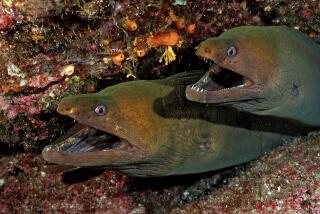A Rare Fossil, the Nautiloid, Is a Rare Find
- Share via
Orange Coast College Profs. Dennis Kelly and Jay Yett were hiking along a creek in Silverado Canyon last October, looking for a place to take their classes on a field trip.
In the midst of a shale area of a uniform grayish color, a round object, considerably darker than the shale, protruded just above the water’s edge. The object clearly was not a stone or part of the shale.
mass that commonly contains fossils.
“We thought it might be a concretion, a mass that commonly contains fossils,” Yett said.
They took it to their campus in Costa Mesa and cleaned it. Kelly, a marine biologist, and Yett, a geologist, said they were amazed at what they had discovered. “We had found a fossilized nautiloid,” Kelly said. “It’s apparently one of the few intact ones in the world.” The fossil weighs about 10 pounds and measures about 12 inches in diameter.
Maneuvered Like Submarine
The nautiloid is a remnant of a life system that existed 90 million years ago, when the area that is now Orange County was under a warm-water sea. Among the strange creatures there was a round shellfish, about a foot long, embossed with spiraling circles. This mollusk, a nautiloid, had delicate air chambers that allowed it to rise and descend in the water like a submarine.
“The nautiloid is a survivor,” Kelly said. “The descendant of this is still alive; it’s like a living fossil. The nautiloid is related to the nautilus, which still exists in the South Pacific.”
Kelly said that scientists are especially interested in the properties that allowed the fragile nautiloid to adapt while the mighty dinosaur became extinct.
Since most evidence of ancient nautiloids has been mainly in fragments of fossils, Kelly and Yett said, a complete, intact fossil offers greater opportunities for study.
“Eventually we’ll give this to a museum, possibly the Los Angeles County museum,” Yett said. For now, it is being exhibited at the Center for Applied Sciences Building on the OCC campus.
The nautilus, Kelly said, “is very interesting from a marine biologist’s standpoint because no other animal in the ocean has these (air) chambers. The nautilus can change the buoyancy of its body by either adding or removing gas from the separate chambers. By doing that, the animal can achieve neutral buoyancy, which in the ocean is the No. 1 energy-saving device. It can float perfectly still in the water, without swimming, or it can go up or down without swimming.
“It’s like a little submarine. And that (nautiloid) was its ancestor.
The fossil also gives “. . . an indication of what the environment was like, right here in Orange County, 90 million years ago,” Kelly said. “Plus there is just a chance that this might be a link between the most primitive type of nautiloid and the modern chamber nautilus. This could be an important find in studying the evolution of the nautilus,” Kelly said, adding:
“These nautiloids had something going for them that made them survivors. And if we’re going to survive in the future, maybe that’s something we ought to learn.”
More to Read
Sign up for Essential California
The most important California stories and recommendations in your inbox every morning.
You may occasionally receive promotional content from the Los Angeles Times.













